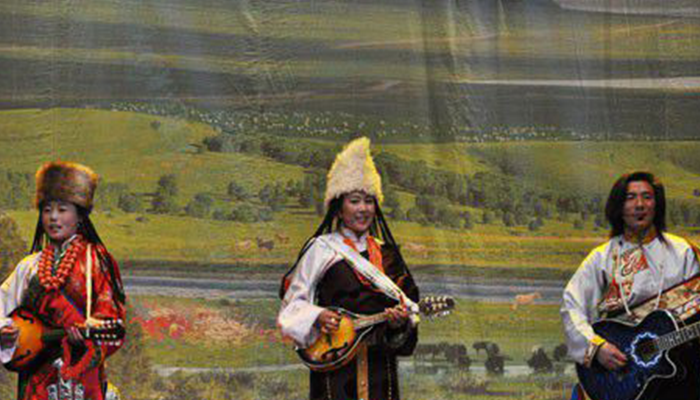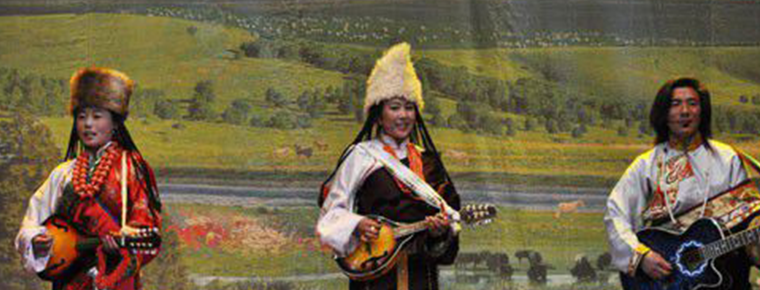Zamuni of Tibetan Nationality Playing and Singing
Zamuni of Tibetan Nationality Playing and Singing
"Zamuni" is also called the Six Stringed Orchestra, a traditional Tibetan plucked instrument. Mainly spread in Lhasa, Shannan, Ali, Lazi (Bahir), Sakya, Angren, Dingri and other places. Tibetan can be translated as "beautiful and melodious voice", which is the main accompaniment instrument for folk songs and dances, and for the performance and singing of Kuangma and Zamuni. It can also be used for self-entertainment in daily life. Zamuni's playing and singing is widely spread in the Qinghai-Tibet Plateau, which has a great influence on the Tibetan inhabited areas in Qinghai and has a long history of playing and singing art. It has a history of more than 1000 years. Zamuni is a Tibetan plucked instrument with a long history. In Tibetan, "Zha" is a sound, "Nie" means pleasant to listen to, and "Zha Mu Nie" means pleasant to listen to. The history of modern Tibetan society has distinct characteristics in national language, music, singing and dancing.
On June 7, 2008, Zamuni, a Tibetan, was listed in the second batch of national intangible cultural heritage list with the approval of the State Council.
historical origin
Zamunie: Also known as "Munie" or "Zhanmunie". The older plucked instruments of the (zang or cang) clan. It has a long history and is widely spread in (Yinzang or Cang) ethnic areas. Because of the six strings, the Han people are called the "zang or cang" six strings. It is the main accompaniment instrument of classical singing and dancing bagma and folk singing and dancing in the West (Yinzang or cang), and also used for solo.
(Yinzang or cang) is a people who can sing and dance. As early as 1300 years ago, Songzan Ganbu period, there were more complete songs and dances. In Tang Dynasty, Zamuni was introduced from the interior to the West (Yinzang or cang). From the ancient murals, it can be seen that Zamuni was not only pulled by hand, but also played by bow.
"Cihai": "Zamunie,... The shape is one size, the body is wooden, the resonance box is like a cut gourd, covered with snakeskin or sheepskin, the pole is long, inexpensive, six strings, two adjacent strings are divided into three groups, according to the four-degree relationship.
artistic characteristics
"Zamuni Dance and Singing" is widely spread in the Qinghai-Tibet Plateau, which has a great influence on the Tibetan inhabited areas of Qinghai and has a long history of playing and singing art. It has a history of more than 1000 years. Zamuni is a Tibetan plucked instrument with a long history. In Tibetan, "Zha" is a sound, "Nie" means pleasant to listen to, and "Zha Mu Nie" means pleasant to listen to. Zamuni is a four-degree relational range piano, which includes three-string piano, four-string piano, six-string piano and eight-string piano.
Zamuni's dancing and singing records the history of modern and modern Tibetan society in a unique artistic form. It has distinct personality characteristics in national language, music, singing and dancing. It fully embodies the humanistic spirit, artistic character, living condition and social style of modern Tibetan society, and has special research value in cultural anthropology, national art and national religion.
Tibetan Zamuni Dance and Singing was listed in the "Second National List of intangible cultural heritage" in 2008.
Introduction of Zamuni
Zamuni, also known as Zanian. Tibetan stringed instruments. Because it has six strings, it is also called the six-stringed piano. It is popular in Tibet Autonomous Region, Sichuan, Yunnan, Qinghai, Gansu and other places. According to the Tibetan historical book "Red History", Zamunie was introduced from the mainland in the Tang Dynasty. Made of mahogany, walnut or sandalwood, 108 cm in length. The speaker is half-gourd-shaped, 29 cm long. The upper part is small and prismatic. The lower part is large and oval. It has Mongolian goat skin or Swertia skin. The piano pole is slender and the fingerboard is of no quality. The piano head is curved half-arc backward, six axes are arranged on both sides, and the top is carved into a faucet or without decoration. It is often used for singing, dancing and singing accompaniment, as well as for instrumental ensemble or solo. The solo repertoires are mostly accompaniments for singing and dancing, such as "Amalehuo", "Dava Slave" and "Yeji Changmu".


-
1.Kunming World Horticultural Expo Garden
Kunming World Horticulture Expo Garden (hereinafter referred to as the World Horticulture Expo Garden) is the site of the 1999 Kunming World Horticulture Expo.
Time 2018-12-12 -
2.suyukou national forest park
Suyukou National Forest Park is located in Helan Mountain National Nature Reserve, 50 kilometers northwest of Yinchuan City, capital of Ningxia. It is a national 4A-level tourist attraction.
Time 2019-02-13 -
3.Weishan Lake National Wetland Park
Weishan Lake National Wetland Park, located in the southern part of Weishan County, Jining City, Shandong Province, is less than 3 kilometers away from the urban area.
Time 2019-02-22 -
4.Bouyei costume Guizhou Province
As a material and cultural phenomenon, the production and change of Buyi costumes are always in line with the social and economic development.
Time 2019-04-04 -
5.Korean Traditional Wedding
The traditional wedding ceremony of the Korean nationality in China is formed by the continuous integration and development of the Korean ancestors with the Han nationality and other minority
Time 2019-04-16 -
6.Old soup essence formula
The formulation of Royal Food Old Tangjing includes the formulation and production technology of Old Tangjing, which is a valuable cultural treasure in the history of condiment development in China. T
Time 2019-05-11 -
7.Linxia brick carving
Linxia brick carving (also known as Hezhou brick carving) is a practical art closely combined with buildings. Linxia brick carving matured in the Ming and Qing dynasties, and in modern times it absorb
Time 2019-05-13 -
8.Manufacturing Techniques of Tianfu Sauce Elbow
Tianfu Sauce Meat Shop was founded in 1738, the third year of Qianlong in Qing Dynasty, when Shandong was in a severe drought and there was no grain harvest. Liu Fengxiang, a man from Yexian County, S
Time 2019-06-20 -
9.Yi Quan
Yiquan, also known as Dacheng Quan, is one of the traditional Chinese boxing and belongs to Neijia Quan. It comes from mind boxing. Including: standing pile, trial, footwork, strength, sound test, pus
Time 2019-07-13 -
10.Bamboo Paper Making Skills
Bamboo paper production maintains a complete traditional process. It is manually made by dipping paper. There are 15 links and 72 processes from material selection to paper making. The production proc
Time 2019-08-10 -
11.Beijing Technology and Business University
Beijing University of Industry and Commerce is a multi-disciplinary university in Beijing. It was approved by the Ministry of Education in June 1999 by the merger of Beijing Institute of Light Industr
Time 2019-09-06 -
12.Luzhou cuisine
Sichuan hotpot, famous for its hemp, spicy, fresh and fragrant, is the representative of Sichuan cuisine. It is said that the birthplace of Sichuan hotpot is xiaomitan in Luzhou (near Gaoba, Luohan street, Longmatan District).
Time 2020-12-14